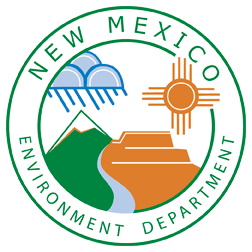Groundwater is a valuable resource!
- Poorly constructed or failing septic systems may contribute to contamination of Ground Water.
- Poorly constructed wells may also allow contamination to migrate along the well casing, contaminating deeper aquifers.
Exposure to contaminated Ground Water may result in disease or illness.
Shallow Ground Water may be more susceptible to contamination because it may be in closer proximity to contaminants from septic systems. This means that areas along the Rio Grande and other rivers may have shallow Ground Water conditions that need to be considered when constructing septic systems.
In addition, the underlying geological conditions may allow contaminants to migrate easily to a larger area, thus possibly exposing more people to disease or illness.
It is important to make sure that setbacks (required horizontal separation distances) and clearances (required vertical separation distances) are met. The Liquid Waste Regulations require 4 feet of clearance, vertical separation between the bottom of a trench (absorption area) and an aquifer, water table or other limiting layer such as bedrock. In general, setbacks prevent cross-contamination between a Ground Water source and a contamination source.
Considering that septic tanks are supposed to be water-tight, 50 feet or more is considered a safe separation distance between septic tanks and wells. Furthermore, drainfields/leachfields receive septic effluent and should be located at least 100 feet away from any wells. Public wells require increased setbacks of at least 100 feet between the septic tanks and public wells and more than 200 feet between the drainfields and public wells.
Diseases and Illnesses
Waterborne diseases kill millions of humans per year. Incidence of waterborne diseases have been reduced drastically in the US during the 1900’s as Germ Theory became understood and allowed for better sanitation practices related to treatment and disposal of human and animal wastes.
A short list of waterborne illnesses include:
- Blue Baby Syndrome (Methemoglobinemia) is a disease that may be caused by exposure to Nitrate in drinking water. Infants and pregnant women are especially susceptible. The disease cause problems with oxygen uptake and may lead to seizures, brain damage and even death.
- Cholera is a disease caused by exposure to bacterium found in human feces. The disease causes diarrhea, dehydration, electrolyte imbalance and may result in death. Thousands of people die each year from Cholera. Improved sanitation and clean drinking water help to prevent this disease.
- Cryptosporidiosis
- Giardia
- E. coli Infection
- Dysentery
There are many other waterborne illnesses that are possible.
The New Mexico Environment Department’s Liquid Waste Disposal and Treatment Regulations are intended to reduce the incidence of waterborne illnesses by minimizing the chance for Ground Water to be contaminated with human and animal waste.

